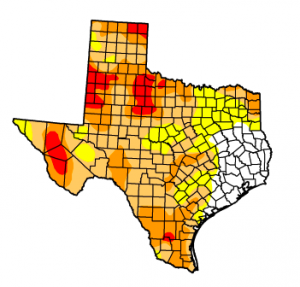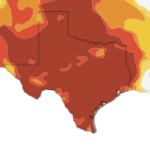Drought Update: The Week the Rains Came to Texas

US Drought Monitor Map
The US Drought Monitor Map of July 19 shows marked success for Central and East Texas after just one week of strong rains.
Extra! Extra! It’s the Drought Monitor Map we’ve been waiting for – the one that tallies last week’s plentiful rains. As expected, much progress was made. Perhaps the most notable change on the map: almost all of Southeast Texas is in the white, meaning completely drought-free and likely to stay that way.
In addition, the rains were so strong in Central Texas that parts of the area moved down a whole drought stage in just one week. Travis County, which contains Austin, moved from Stage 2 of the drought to mostly Stage 1. (There is still a small sliver in the northwestern part of the county in Stage 2.) Williamson County, directly north of Travis County, moved from mostly Stage 3 to mostly Stage 2. Several counties west of San Antonio moved from Stage 2 to Stage 1 in just one week as well.
As Texas gradually pries itself out of drought, much of the rest of the country delves deeper into it. According to the National Climactic Data Center, 56 percent of the US is now facing drought conditions. This is significant because it is the largest percentage of area since the infamous drought period of the 1950s. Since much of this is taking place in America’s Corn Belt, officials are concerned about the increase in the price of grain, especially corn.
Back in Texas, progress was real and rapid last week, but do residents of the state no longer need worry about the drought? The consensus amongst some of the state’s meteorologists: the rainfall was great, but it’s gonna take a lot more than a week’s worth of rain to get out of a two-year long record drought.
As we’ve reported before, the long-term outlook is cause for optimism because of the forecasted formation of an El Niño in the Pacific, which is known to bring wet conditions to the state. In fact, the Pacific Ocean has already reached the temperature threshold needed for an El Niño, says state climatologist John Nielsen-Gammon. The only thing lacking to make it official is “to see whether it lasts” for several months.
“The effects of the El Niño kick in around November,” says Nielsen-Gammon. In addition, he explains that September and October are “typically fairly wet months” for Texas. The major concern, then, is how the precipitation situation will play out through the rest of the summer.
Victor Murphy of the National Weather Service says that last week’s rain bought us a few weeks, maybe three, for at least maintaining the drought status quo. But he adds that forecasts for the next several weeks indicate dry weather. This is likely to lead to a slight deterioration as the summer closes out.
Bob Rose, meteorologist for the Lower Colorado River Authority, also foresees a “drier trend as we finish out July and go into August.” However, he’s slightly more optimistic about the chance of rain coming in from the Gulf of Mexico. In the end, he explains that there should be “no huge deterioration” within the next couple of weeks unless things just turn completely dry.
Nielsen-Gammon concurs with this outlook. “It actually looks fairly promising that we might not have major deterioration between now and when El Niño kicks in.”
So just what exactly will it take to get out of this drought? It mostly has to do with the replenishing of our waterways. “Hydrologic impacts – water supply, reservoirs, stream flow – tend to be most sensitive to longer timescales because, for example, reservoirs hold multiple years-worth of run off,” says Nielsen-Gammon. “And so the fact that the rainfall from the current year hasn’t made up for the deficit built up last year means there’s still hydrologic drought present in Central Texas.”
But of course, our waterways cannot refill unless there is water falling from the sky. It may fall soon, or we might have to wait for wetter seasons.
Daniel Ramirez is an intern with StateImpact Texas.






